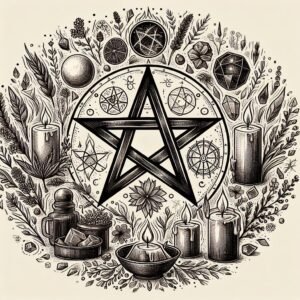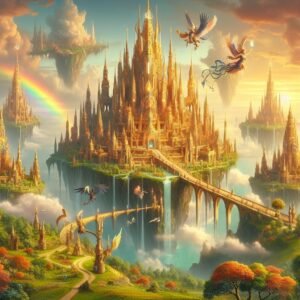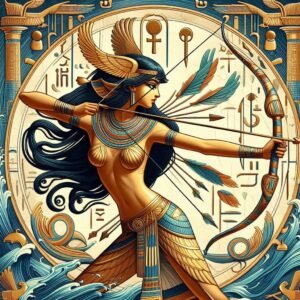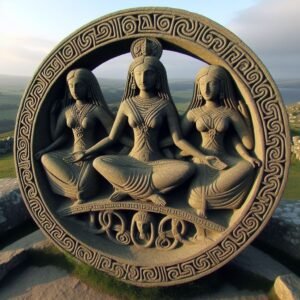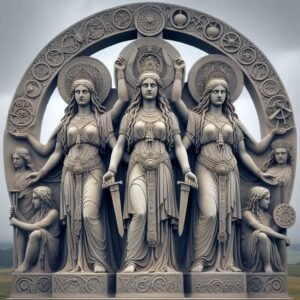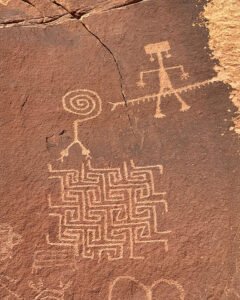
The Anunnaki
The Anunnaki, a term that resonates with the echoes of ancient Sumer, refers to a pantheon of deities revered by the Sumerians, Akkadians, Assyrians, and Babylonians. These divine beings were considered the offspring of An, the supreme god of the sky, and Ki, the earth goddess, embodying the celestial and terrestrial realms’ union. The Sumerians believed that the Anunnaki were the architects of their fates, decreeing the destinies of humanity from their lofty abodes.
In Sumerian mythology, the Anunnaki held a place of prominence, their narratives intertwined with the creation of the world and the ordering of the cosmos. The Sumerians depicted these gods with horned crowns, symbolizing their regal and divine status, and believed them to possess extraordinary powers and immense physical stature. The Anunnaki were thought to wear melam, an enigmatic substance that shrouded them in a terrifying splendor, inspiring awe and reverence among mortals.
The eldest of the Anunnaki was Enlil, the god of air and the chief deity of the Sumerian pantheon. According to myth, before Enlil’s birth, heaven and earth were inseparable. It was Enlil who, upon his emergence, cleaved the heavens from the earth, establishing the firmament above and the ground below. His father, An, carried away the sky, while Enlil claimed the earth, setting the stage for the drama of life to unfold.
The Anunnaki’s influence extended beyond the spiritual, as they were believed to be intimately involved in the governance of the world. Each member of this divine assembly had their own individual cult, and while no evidence of a collective cult has been unearthed, the Sumerians revered them through literary texts and individual worship. The Anunnaki were not merely passive observers but active participants in the affairs of gods and men.
Evolution of the Anunnaki
The Sumerian’s understanding of the Anunnaki was not static but evolved, as did their portrayal in art and literature.
Initially, the Anunnaki were described as gods who visited Earth, but later texts suggest they resided in Heaven. Their statues were considered physical embodiments of the gods themselves, and the Sumerians engaged in rituals to honour these divine figures, dressing them in elaborate garments and presenting them with offerings.
The Anunnaki’s role in Sumerian society was multifaceted. They were seen as the granters of kingship, the overseers of justice, and the arbiters of the natural order. The Sumerians credited the Anunnaki with bestowing upon them the gifts of civilization, such as the plough and cuneiform writing, which were instrumental in the empire’s growth and prosperity.
The Sumerians’ reverence for the Anunnaki was reflected in their religious practices. They created statues to represent the gods, clothed them, fed them, and transported them to ceremonies, treating them as honoured guests among the living. This deep respect for the Anunnaki was rooted in the belief that these gods shaped the destiny of their society, guiding them through the vicissitudes of life and ensuring their continued success.
The Anunnaki’s legacy is preserved in the annals of history, their stories and attributes influencing subsequent cultures and religions. Their myths, such as the Epic of Gilgamesh, one of the oldest written stories in human history, continue to captivate scholars and enthusiasts alike. The Sumerians’ understanding of the Anunnaki offers a glimpse into the ancient world’s spirituality and its conception of the divine’s role in human affairs.
The key Anunnaki
The Anunnaki gods each played distinct and pivotal roles that reflected the values and phenomena of the world as perceived by the ancient Sumerians.
The seven great deities of Sumer, often referred to as the “seven gods who decree,” were central figures in Sumerian religion. They included:
An (Anu): The god of the heavens.
Enlil: The god of wind and storm.
Enki (Ea): The god of water and human culture.
Ninhursag (Ninmah): The goddess of fertility and the earth.
Nanna (Sin): The god of the moon.
Utu (Shamash): The god of the sun and justice.
Inanna (Ishtar): The goddess of love, beauty, and warfare.
These deities played crucial roles in Sumerian mythology and were believed to govern various aspects of the natural and social order.
Anu (An), the sky god, was the supreme ruler of the divine assembly, his dominion extending across the heavens, embodying cosmic authority and balance. As the guardian of the Tablets of Destiny, Anu held the power to determine the fates of all beings, a role that underscored his paramount importance in the celestial hierarchy.
Ninhursag (Ki), known as the mother of all living beings, was the goddess of fertility and the earth. Her role was to ensure the prosperity and well-being of the land and its people. She was often called upon for blessings of fertility and was a key figure in myths related to birth and life. She has been named as the consort to bot Anu, and Enki.
Enlil, another prominent member of the Anunnaki, was revered as the god of air and the king of the gods. His influence was vast, presiding over the wind, breath, and loftiest aspects of existence. Enlil’s decisions were crucial in shaping the destinies of both gods and humans, and he played a central role in myths concerning creation, fertility, and divine judgment.
Ninlil (Sud), the consort of Enlil, was the queen of heaven and earth. She was associated with the air like her husband and was involved in myths concerning the creation of the wind and the vital breath that animates all life.
Enki, the god of water, wisdom, and creation, was a master craftsman and the shaper of the world. His domain included the freshwater abyss of the Abzu, and he was responsible for the flow of rivers and the fertility of the soil. Enki was also the god of intelligence and mischief, often depicted as a patron of humanity, aiding them with his gifts of knowledge and invention.
Nammu is a primordial goddess in Sumerian mythology, often associated with the creation of the universe and humanity. She embodies the primeval waters, an elemental force from which life and the pantheon of gods emerged. As a creator deity, Nammu’s role is pivotal in the cosmogony of Mesopotamian belief systems, where she is revered as the mother who gave birth to the major deities, including Enki, the god of wisdom, water, and creation.
Sin, also known as Nanna or Suen, was the personification of the moon in Mesopotamian mythology. As the celestial counterpart to Shamash, Sin governed the night and was associated with fertility, cattle herding, and the tides, reflecting the moon’s importance to ancient agrarian societies. His worship was centred in Ur and Harran, and he was often depicted with a crescent moon, symbolizing his domain over the lunar cycle.
Ereshkigal and Nergal, rulers of the underworld, presided over the realm of the dead. Ereshkigal was the queen of the underworld, a goddess who embodied the finality of death and the darker aspects of existence. Nergal, her consort, was associated with plague and war, and together they governed the fates of the deceased.
Utu, also known as Shamash in Akkadian, is the ancient Mesopotamian sun god. He was revered as the god of justice, truth, and protection for travellers. Utu was believed to see everything that happened during the day, making him a divine judge. He was the son of the moon god Nanna (Sin) and the goddess Ningal, and the twin brother of Inanna (Ishtar). Utu was particularly venerated in the cities of Sippar and Larsa, and his symbol was the solar disc.
Ninsun, the divine matron of heroes, was revered for her wisdom and her role as the mother of the epic hero Gilgamesh. She was a figure of guidance and insight, often invoked in matters of state and heroism.
Lugalbanda, the god of knowledge and inspiration, was celebrated for his intelligence and his role as a cultural hero. He was often associated with the arts and the pursuit of wisdom.
Marduk, (Syncretised with Enlil) who rose to prominence in Babylonian mythology, was a powerful god associated with creation and kingship. He was credited with defeating the primordial sea goddess Tiamat and creating the world from her body, establishing order from chaos.
Ninurta, the heroic god of war and agriculture, was a defender of the gods and a champion of mankind. His attributes included strength, valour, and the ability to bring fertility to the land through his control over the waters.
Inanna, also known as Ishtar, was the queen of heaven and earth, the goddess of love, beauty, war, and political power. Her myths are among the most complex and vivid, detailing her descent into the underworld and her role as a deity who could bestow kingship and favour upon her worshippers.
The Igigi are a group of mythological figures in Mesopotamian mythology. They are often considered the younger gods who served the Anunnaki, the major deities. According to the Atrahasis myth, the Igigi were tasked with laborious work for the Anunnaki until they eventually rebelled due to the harsh conditions.
The Anunnaki’s roles were not limited to these descriptions, as their influence permeated every aspect of Sumerian life. They were seen as the ultimate arbiters of the cosmos, their will manifesting in the natural world, the affairs of states, and the lives of individuals. The Sumerians’ understanding of the Anunnaki was complex, with each god or goddess fulfilling multiple functions within the pantheon. These deities were integral to the Sumerians’ interpretation of the world, providing a framework for understanding the forces of nature, society, and the divine. The Anunnaki were more than just mythological figures; they were central to the Sumerians’ world-view, offering guidance, wisdom, and the promise of order in a world that could often seem chaotic and unpredictable.
Internal conflicts within the Anunnaki
The Anunnaki were often depicted as having conflicts and rivalries among themselves, mirroring the complex dynamics of human societies. These divine beings, while embodying supreme powers and ruling over various aspects of the cosmos and human life, were not immune to discord. One of the most notable rivalries was between Enki and Enlil, two of the most powerful gods within the Anunnaki. Enlil, the god of air and the king of the gods, was often at odds with his brother Enki, the god of water and wisdom. Their disagreements stemmed from their differing domains and responsibilities, as well as from the distinct approaches they took towards humanity.
Enlil, who held dominion over the wind and the breath of life, was known for his stern and sometimes wrathful demeanour. He was a figure of authority and order, often seeking to maintain the status quo and the divine order.
In contrast, Enki was more benevolent and often acted as a protector and benefactor of humans. He was credited with creating mankind and frequently intervened on their behalf, which sometimes put him in direct conflict with Enlil’s harsher judgments.
Another source of divine conflict involved Inanna, also known as Ishtar, the goddess of love and war. Inanna’s assertive personality and her quest for power led to several confrontations with other gods. Her desire to expand her influence and domain brought her into conflict with the likes of Enki, whom she tricked to obtain the sacred mes, objects that represented various aspects of civilization and divine powers.
The Anunnaki also faced internal strife when it came to matters of succession and leadership. The struggle for power and control among the gods often resulted in alliances and enmities that could lead to larger conflicts. For instance, the myth of the descent of Inanna into the underworld to confront her sister Ereshkigal, the queen of the dead, is a vivid depiction of the rivalries that could arise from personal ambitions and the quest for dominance.
These conflicts among the Anunnaki were not merely petty squabbles, but were reflective of the Sumerians’ understanding of the universe as a complex and often tumultuous place. The gods, in their eyes, were not infallible beings but possessed human-like qualities, including jealousy, ambition, and the capacity for both benevolence and wrath. The myths and stories that describe the rivalries among the Anunnaki serve as allegories for the trials and tribulations of human existence, as well as the challenges of governance and the balance of power.
The Anunnaki’s rivalries had significant implications for the world of humans, as the outcomes of these divine conflicts could result in blessings or curses for mankind. The Sumerians believed that the actions of the gods directly influenced their lives, from the fertility of their crops to the success of their cities. Thus, the tales of strife among the Anunnaki were not just entertainment but carried profound religious and existential weight, shaping the Sumerians’ world-view and their place within the cosmic order.
In conclusion, the Anunnaki’s conflicts and rivalries are integral to Sumerian mythology, providing insight into the Sumerians’ conception of the divine and the natural world. These narratives underscore the complexity of the Anunnaki pantheon and the multifaceted nature of their interactions, both with each other and with humanity. The stories of the Anunnaki continue to fascinate scholars and enthusiasts alike, offering a window into the ancient Sumerians’ rich spiritual and cultural heritage. The enduring legacy of these myths speaks to the timeless nature of the themes they explore, from the dynamics of power and authority to the universal experiences of conflict and resolution.
The Book of Enoch
The Book of Enoch is an ancient Jewish religious work, ascribed by tradition to Enoch, the great-grandfather of Noah. It is not part of the biblical canon as used by Jews, apart from Beta Israel. Most Christian denominations and traditions may accept the Book of Enoch as having some historical or theological interest, but they generally regard the Book of Enoch as noncanonical or noninspired. The text consists of various sections, the oldest of which is the Book of the Watchers, dating from around 300 BC. The latest section, the Book of Parables, is believed to date from about 100 BC.
This work is largely apocalyptic in nature, which was a genre of revelatory literature with a narrative framework, where a revelation is mediated by an otherworldly being to a human recipient, disclosing a transcendent reality which is both temporal, insofar as it envisages eschatological salvation, and spatial, insofar as it involves another, supernatural world. As such, it contains a rich description of the origins of demons and giants, why some angels fell from heaven, details of the great flood, and the future resurrection of the dead.
Enoch contains unique material on the origins of demons and giants, and is also notable for its description of the fallen angels and the Nephilim, or giants, who are the offspring of the sons of God and the daughters of men.
Despite its exclusion from the canon, the Book of Enoch was widely read and revered in the early Christian Church and is quoted by Jude, suggesting that its influence was widespread in the development of early Christian thought and theology. Its themes and concepts are reflected in the New Testament, particularly in the Book of Revelation.
The Book of Enoch only survives in its entirety in the Ge’ez language, with Aramaic fragments found in the Dead Sea Scrolls. It is part of the biblical canon used by the Ethiopian Orthodox Tewahedo Church and Eritrean Orthodox Tewahedo Church, but not by other Christian groups. The discovery of the texts from Qumran Cave has provided scholars with valuable insights into its origins and historical context.
The Watchers
One of the central themes is the detailed account of the Watchers, angels who fell from heaven due to their rebellion and interactions with humanity. This narrative, found in the Book of the Watchers (chapters 1–36), explores the consequences of the Watchers’ actions, including the birth of the Nephilim, and Enoch’s attempts to intercede on their behalf. The Book of Parables (chapters 37–71) introduces the figure of the “Son of Man,” a messianic entity who is prophesied to bring judgment and salvation, reversing the fortunes of the oppressed and condemning their oppressors. This figure is later identified as Enoch himself, drawing parallels with the New Testament portrayal of Jesus as the “Son of Man”.
The text also provides prophetic visions of the end times, including the thousand-year reign of the Messiah, which has been influential in shaping Christian eschatological thought.
The Elohim
The term “Elohim” has a complex and multifaceted history within ancient texts, particularly the Hebrew Bible. It is a Hebrew word that is grammatically plural; however, it most often refers to a single deity, especially the God of Israel. In some contexts, “Elohim” is used to denote the gods of other nations or to refer to deities in the plural sense. The ambiguity of the term may reflect shifts in the concept of divinity throughout the early history of Israelite religion, from a broader pantheon to a more singular, monolatrist worship, and eventually to monotheism.
This evolution in understanding is evident in the varying uses of “Elohim” to refer to God, angels, judges, and even foreign gods. The term also appears in the phrase “Bene Elohim,” which means “Sons of God,” and refers to divine beings or angels who are part of God’s heavenly court. The scholarly debate continues on the precise interpretation of “Elohim” in different biblical passages, but it undeniably plays a significant role in the theological and literary development of the concept of God within ancient Jewish culture.
Elohim’s usage is a testament to the rich and dynamic nature of language and religious thought in the ancient world. Elohim’s grammatical plurality can be seen as a form of respect or majesty, similar to the royal “we” used by monarchs. This plurality might also suggest the manifold qualities of the divine, encompassing a spectrum of attributes and powers.
It could, therefore, be suggested that in their original form, the Elohim were a plural group of entities that embodied different aspects of the divinity – fundamental creator Gods, which, over time, become integrated into the concept of one “God”, with many helpers, such as angels.
Parallels with the Anunnaki
The Watchers and the Nephilim, as described in the Book of Enoch, share intriguing parallels with the Sumerian Anunnaki, suggesting a potential connection between these ancient mythologies. The Watchers, known as fallen angels who descended to Earth and interacted with humans, bear resemblance to the Anunnaki, who were also divine beings associated with the heavens and the earth.
The offspring of the Watchers, the Nephilim, were described as giants, which aligns with some interpretations of the Anunnaki as being of great stature and possessing significant power. If we were to consider the Anunnaki as a collective term that includes Watchers and Nephilim, and Also potentially the Elohim, then we may see that there is a hierarchy of divine presence represented by the term Anunnaki pointed at by Hebrew texts that provides a specific function to these three types of spiritual characters.
The Sumerian texts predate the Book of Enoch, and it is possible that the stories of the Anunnaki influenced later Semitic traditions, including those found in the Hebrew Bible. The Anunnaki were considered creators and shapers of humanity, roles that are similar to the actions attributed to the Watchers in the Book of Enoch. Moreover, the Anunnaki were said to have imparted knowledge and skills to humans, a theme that is echoed in the narrative of the Watchers teaching forbidden knowledge to mankind.
The Nephilim, as the progeny of the Watchers and human women, were often depicted as mighty warriors and men of renown, which could be seen as analogous to the roles played by the Anunnaki in shaping human civilizations and their heroic narratives. The concept of divine beings intermingling with humans and producing offspring is a common motif in many ancient mythologies, including the Sumerian.
Furthermore, some interpretations suggest that the biblical Garden of Eden may have been inspired by Sumerian descriptions of a heavenly garden, with the Anunnaki being linked to the Watchers who were responsible for watching over this paradise. This connection points to a shared cultural heritage that spans across different civilizations and epochs, reflecting a collective attempt to understand the divine and its interaction with the human world.
Proposed link with hidden forms of governance
We can therefore posit an interpretation of the Anunnaki as follows:
Elohim – The creator Gods that most equate to the descriptions of the Mesopotamian Anunnaki, the first beings created by God to help share the burden of creation.
The Watchers, or fallen angels, also known as demons, beings that may have first come to earth as giants, but whose main influence today is through their role as a watcher (an entity that monitors a great many humans, influences their thoughts and makes sure none are breaking out of the perception of reality that they are intended to have by the Anunnaki.
The Nephilim – These can be thought of as human hosts for the Watchers or even the Anunnaki. Those hosts can be temporary “walk-ins” or longer term “possessions”, these hosts can either be unwitting, or in full knowledge of that “walk-in” or “possession”. Many of those anonymous individuals conspiracy theorists call “The Cabal”, may well be, in effect, fully aware Nephilim, and be captains of industry or community leaders in some other way, helping to guide society on the right course dictated by the Anunnaki. They may also be that random drunk that does something stupid, which helps or hinders others.
This connection between these two concepts of Anunnaki and Our leaders, captains of industry, and thought leaders is not established in scholarly literature or historical texts but, is rather a subject of speculation among enthusiasts of mythology and conspiracy theories. There is no evidence to support the theory, but, if it were true, there wouldn’t be.
“Appointed by God”
Throughout history, many royal figures have claimed divine lineage to justify their rule and authority. This concept, known as the divine right of kings, posits that a monarch’s right to rule is directly ordained by God, making them answerable only to divine will and not to any earthly authority. This belief was particularly prevalent in Europe during the Middle Ages and the Renaissance, where it was used to support the notion of monarchical absolutism.
For instance, monarchs like Henry VIII of England and Louis XIV of France were staunch adherents to this doctrine, which played a significant role in the political and religious life of their times. Henry VIII’s Acts of Supremacy, for example, were a declaration of the king’s supremacy over the Church of England, effectively placing him at both the spiritual and temporal helm of the nation. Similarly, Louis XIV’s reign in France was marked by an increase in absolutism, with the king often referred to as the ‘Sun King’, a metaphor for his perceived role as the source of light and life for his nation.
The Glorious Revolution in England and the Enlightenment across Europe saw a gradual decline in the acceptance of divine right, with more secular philosophies taking precedence.
In the context of divine lineage, these claims were often bolstered by genealogical constructions that traced royal bloodlines back to deities or legendary heroes. Such assertions served not only as a political tool, but also as a cultural narrative that reinforced the social hierarchy and the sanctity of the monarchy. However, the veracity of these claims was rarely subject to empirical scrutiny; they were matters of faith and tradition rather than historical fact.
Whether the claims of divine lineage by royal figures could originate from the myths of the Nephilim is a fascinating one, blending the realms of mythology, theology, and history. The Nephilim, as described in ancient texts, are often associated with great size and strength, considered to be the offspring of divine beings and human women. This concept of beings born from a mix of divine and human essence is a recurring theme in many mythologies and religions around the world.
In the context of royal figures claiming divine lineage, it is possible to speculate that such claims could be metaphorically linked to the idea of the Nephilim, as both involve a connection to the divine. Throughout history, rulers have often used claims of divine favour or descent to legitimize their authority, and the notion of being descended from a powerful, otherworldly entity like the Nephilim could serve to reinforce a ruler’s status and power.
It is important to note that there is no direct historical evidence to support a literal connection between the myths of the Nephilim and the divine lineage claimed by royal figures.
The myths of the Nephilim and the claims of divine lineage by royalty share a common thread in that they both elevate certain individuals above the common populace, granting them an aura of mystique and authority that is not easily challenged. In societies where such beliefs are or were prevalent, the association with the divine or the semi-divine can serve as a powerful tool for maintaining social hierarchies and justifying the rule of the elite.
While the idea of a direct lineage from the Nephilim to historical royal figures is a matter of speculation and personal belief, the broader concept of divine or semi-divine ancestry plays a significant role in the mythologies and power structures of many cultures.
The myths surrounding the Nephilim are as varied as they are ancient, with interpretations and narratives differing widely across cultures. In the Hebrew Bible, the Nephilim are described in the Book of Genesis as the offspring of the “sons of God” and the “daughters of men,” often associated with great size and strength, and sometimes with a reputation for violence and corruption. This enigmatic description has led to a multitude of interpretations over the centuries, ranging from giants to fallen angels.
Similarities with other cultures
In other cultures, similar beings appear under different names and contexts. For example, in Greek mythology, the Gigantes were a race of giants born from the earth who battled the Olympian gods in the Gigantomachy. The Greek heroes, demigods born from the union of a god and a human, also echo the theme of semi-divine beings walking the earth. In Norse mythology, the Jotnar, often translated as giants, were beings with superhuman strength and were sometimes adversaries, sometimes allies, of the gods.
The concept of beings that bridge the divine and the human can also be found in the legends of the Tuatha Dé Danann in Irish mythology, who were said to be god-like beings that once ruled Ireland. Similarly, the Anunnaki of Sumerian mythology were deities that were involved in the creation and governance of humanity, and their narratives sometimes overlap with the themes found in Nephilim lore.
In the epic traditions of the Mediterranean, such as those surrounding the city of Troy, there are tales of heroes with divine heritage who possess extraordinary abilities. The Merovingian dynasty in Europe, for instance, was said to trace its lineage back to a mystical sea creature, reinforcing their claim to power with a connection to the supernatural.
The Nephilim have also been linked to the Rephaim, a group of beings mentioned in the Hebrew Bible, who were associated with the dead and the underworld. The Rephaim and the Nephilim are sometimes conflated or considered to be related due to their shared attributes of size and strength, as well as their mysterious origins.
In more recent times, the Nephilim have been the subject of various speculative theories, often linked to ancient astronaut theories or other esoteric beliefs. These modern interpretations sometimes blend ancient myths with contemporary conspiracy theories, suggesting that the Nephilim were actually extraterrestrial beings or advanced prehistoric civilizations.
In Greek mythology, the term ‘Nephilim’ is not used; however, there are entities and characters that could be considered similar to the Nephilim due to their semi-divine nature and great strength. One of the most notable examples is the demigods, the offspring of gods and mortals, who often possess extraordinary powers and abilities. Heracles, also known as Hercules, is perhaps the most famous of these; he was the son of Zeus and the mortal woman Alcmene. Heracles is renowned for his incredible strength and for completing the Twelve Labours, a series of tasks that required both immense power and cunning.
Another example is the Gigantes, who were giants born from the earth and fought against the Olympian gods in the Gigantomachy, a great battle that ensued when the gods challenged the Titans for control of the cosmos. The Gigantes were formidable opponents due to their size and strength, but they were ultimately defeated by the gods, often with the help of Heracles.
The Titans themselves, predating the Olympian gods, could also be seen as Nephilim-like figures. They were a race of powerful deities that ruled during the legendary Golden Age. The Titans were overthrown by their younger relatives, the Olympians, in a struggle known as the Titanomachy. Cronus, the leader of the Titans, was particularly renowned for his might.
In addition to these, there are the heroes of the Trojan War, many of whom had divine parentage and exhibited traits that set them apart from ordinary men. Achilles, the greatest warrior of the Greeks at Troy, was the son of the nymph Thetis and the mortal Peleus. His near invincibility in battle made him a figure of awe and terror.
The stories of Theseus and Perseus also echo the themes found in Nephilim lore. Theseus, the legendary king of Athens, was the son of either Poseidon or Aegeus, the mortal king of Athens, and was known for his many adventures, including defeating the Minotaur in the Labyrinth of Crete. Perseus, another demigod, was the son of Zeus and Danaë and is best known for beheading the Gorgon Medusa.
While the Greek myths do not directly mention the Nephilim, the concept of beings that are part human and part divine, possessing great strength and often tasked with extraordinary feats, is a common thread. These stories have been passed down through the ages, capturing the imagination with tales of heroism, struggle, and the interplay between the mortal and the divine.
While direct evidence of a relationship between the Watchers, Nephilim, and Anunnaki is speculative, the thematic similarities and overlapping narratives suggest a common thread in the ancient Near Eastern mythological tapestry. These stories, whether of the Anunnaki shaping the destinies of humans or the Watchers influencing the course of human history, highlight the ancient fascination with the intersection of the divine and mortal realms.
Do The Watchers exploit the concept that “Everything is connected”?
The notion of interconnectedness is a profound and pervasive concept that has been contemplated in philosophy, spirituality, and science. It suggests that all aspects of the universe are linked, from the smallest particle to the vastest galaxy, and that each entity, whether animate or inanimate, is a part of a grand, intricate tapestry.
This idea resonates with the ancient belief in the Watchers, celestial beings tasked with observing and sometimes guiding human affairs. In many traditions, these Watchers are not bound by the physical laws that govern our reality; they exist in a state that transcends time and space, which enables them to carry out their duties.
In the context of everything being connected, it’s intriguing to consider the Watchers as part of this universal network. If we entertain the thought that they are indeed watching, their vantage point would not be limited by the constraints of our three-dimensional perspective. They would have access to the threads that weave the fabric of existence, seeing the connections that bind events, decisions, and lives together. This perspective aligns with the holistic view that everything that happens is part of a larger pattern, a dance of cause and effect that unfolds across the cosmos.
The idea that every being, including the Watchers, is interconnected also touches on the concept of collective consciousness—a shared pool of knowledge and experience accessible to all. In such a framework, the Watchers’ role could be akin to that of custodians or librarians of this universal knowledge, overseeing the accumulation and flow of wisdom throughout the ages.
Some theories supporting the idea that everything is connected
The concept that everything in the universe is interconnected is supported by various theories across disciplines such as spirituality, philosophy, and science. In spirituality, this idea is often linked to the belief in a universal spirit or consciousness that binds all forms of life.
Philosophically, it can be traced back to ancient Greek Stoicism, which posited that everything is composed of a divine, creative fire, leading to a profound interconnectedness.
In modern times, German idealism also explored the notion that reality is a unified whole. Scientifically, the Big Bang Theory suggests that all matter originated from a single, infinitely dense point, implying a fundamental connection between all physical entities.
Quantum mechanics further supports this interconnectedness through concepts like entanglement, where particles, once entwined, remain connected regardless of the distance separating them. This suggests that on a subatomic level, there is no clear boundary where one object ends and another begins, reinforcing the idea of unity in the universe.
These theories, while diverse in their approaches and implications, all converge on the profound insight that in some way, everything in the cosmos is linked, reflecting a tapestry of existence that is far more intertwined than our senses typically perceive.
Self-Transcendence Theory and Interconnectedness
Self-transcendence theory, as explored by various psychologists including Viktor Frankl, Abraham Maslow, and Pamela G. Reed, posits that individuals have the capacity to go beyond their personal boundaries and connect with something greater than themselves.
This theory aligns with the idea of interconnectedness, suggesting that there is an inherent link between the self and the broader universe. It emphasizes the expansion of self-boundaries not only intrapersonally, by fostering greater awareness of one’s philosophy, values, and dreams, but also interpersonally, temporally, and transpersonally, which involves connecting with dimensions beyond the typically discernible world.
In the context of self-transcendence, the interconnectedness of everything implies that individuals can experience a sense of unity with the greater whole, whether that is humanity, nature, the cosmos, or a divine power. This sense of unity can lead to profound personal growth and an enhanced understanding of one’s place in the universe. It encourages a shift in perspective from a focus on the self to a broader, more inclusive view that encompasses all beings and the entirety of existence.
The theory suggests that through self-transcendence, people can achieve a higher state of being that transcends the limitations of their ego and individuality. This state is characterized by a deep connection to others and the world, leading to a more compassionate and altruistic outlook. It is in this transcendent state that individuals may find a greater purpose and meaning in life, as they realize that their actions and existence are part of a larger, interconnected system.
The theory of self-transcendence also resonates with the concept of the collective unconscious proposed by Carl Jung.
The Collective Unconscious
Carl Jung’s concept of the collective unconscious is a cornerstone of analytical psychology, positing that there exists a segment of the deepest unconscious mind that is genetically inherited and not shaped by personal experience. This collective unconscious is common to all human beings and is composed of archetypes, which are elemental symbols or patterns of thinking and behaving that are inherited from our ancestors. These archetypes manifest in various forms, such as myths, dreams, and even art, reflecting the shared experiences and instincts of humanity across time and culture.
Jung’s theory suggests that the collective unconscious contains the whole spiritual heritage of mankind’s evolution, born anew in the brain structure of every individual. This shared unconscious is responsible for a number of deep-seated beliefs and instincts, such as spirituality, sexual behaviour, and life and death instincts.
The collective unconscious serves as a form of psychic DNA, carrying the memories and experiences of our ancestors. These ancestral experiences then surface in our present consciousness through archetypal images and themes that recur in our personal lives and across cultures and epochs. For example, the archetype of the Great Mother can be found in various cultures, symbolizing creation, birth, fertility, and nurturing, while the Wise Old Man represents knowledge, guidance, and wisdom.
Jung believed that the collective unconscious is expressed through these universal archetypes, which are not static or fixed, but may overlap or combine at any given time. The dynamic interplay of these archetypes within the collective unconscious shapes our perceptions and behaviours, influencing the way we relate to the world and to ourselves. They are the psychic counterpart of instinct and play a crucial role in shaping human behaviour and attitudes.
The collective unconscious also provides a framework for understanding the profound connections between individuals and the collective human experience. It explains why certain themes, symbols, and narratives have a universal resonance, appearing in the myths, religions, and folklore of diverse cultures. It is this shared heritage that binds humanity together, transcending individual experiences and personal unconscious content.
Jung’s exploration of the collective unconscious also extends to the concept of synchronicity, which he defined as the simultaneous occurrence of two meaningfully but not causally connected events. Synchronicity points to the possibility of an acausal connecting principle, where events are linked by meaning rather than by direct cause and effect. This principle further illustrates the interconnectedness of all things, suggesting that the external world can mirror our internal psychic state in meaningful ways.
Subscribe to our post updates - Don't miss a thing!!

